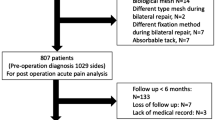Abstract
Background
Chronic post-operative pain (CPP) following laparoscopic inguinal hernia repair (LIHR) may cause significant morbidity and be more problematic than recurrence. Determining pre-operative risk may reduce morbidity. Our aim was to determine prevalence of CPP following LIHR and identify risk factors for its development.
Methods
Data from patients undergoing LIHR (1996–2004) at one District General Hospital were collected, including demographics, body mass index, pre-operative pain, LIHR type (TEP or TAPP, primary/recurrent, unilateral/bilateral) and post-operative complications including CPP (pain lasting ≥1 year).
Results
A total of 881 patients underwent LIHR (1,029 hernias). Of these, 523 (60%) patients completed the questionnaire, and 72/523 (13.8%) patients experienced CPP. Presence of pre-operative pain (P < 0.001), recurrent LIHR (P = 0.021) and age <50 years (P < 0.001) were significantly correlated with CPP.
Conclusion
Chronic post-operative pain following LIHR is more prevalent than recurrence. Pre-operative pain, surgery for recurrent inguinal hernias (following anterior repair) and younger age at surgery predict development of CPP. Identification of ‘high-risk’ patients may improve management, reducing morbidity and cost.
Similar content being viewed by others
References
Poobalan AS, Bruce J, Cairns W, Smith S, King PM, Krukowski ZH, Chambers WA (2003) A review of chronic pain after inguinal herniorrhaphy. Clin J Pain 19:48–54
Healthcare Commission (2005) Commission for Healthcare Audit and Inspection Report. Healthcare Commission, London
Lichenstein IL, Shulman AG, Amid PK (1989) Tension-free hernioplasty. Am J Surg 157:188–193
The EU Hernia Trialists Collaboration (2002) Repair of groin hernia with synthetic mesh. Meta-analysis of randomized controlled trails. Ann Surg 235:322–332
Aasvang EK, Bay-Nielsen M, Kehlet H (2006) Pain and functional impairment 6 years after inguinal herniorrhaphy. Hernia 10:316–321
Page B, Paterson D, Young D, O’Dwyer PJ (2002) Pain from primary inguinal hernia and the effect of repair on pain. Br J Surg 89:1315–1318
Aasvang E, Kehlet H (2005) Chronic postoperative pain: the case of inguinal herniorrhaphy. Br J Anaesth 95:69–76
Nienhuijs S, Staal E, Strobbe L, Rosman C, Groenewoud H, Bleichrodt R (2007) Chronic pain after mesh repair of inguinal hernia: a systematic review. Am J Surg 194:394–400
MRC Laparoscopic Groin Hernia Trial Group (1999) Laparoscopic versus open repair of groin hernia: a randomised comparison. Lancet 354:185–190
Douek M, Smith G, Oshowo A, Stoker DL, Wellwood JM (2003) Prospective randomised controlled trial of laparoscopic versus open inguinal hernia mesh repair: five year follow up. BMJ 326:1012–1013
Liem MS, van Duyn EB, van der Graaf Y, van Vroonhoven TJMV on behalf of the Coala Trial Group (2003) Recurrences after conventional anterior and laparoscopic inguinal hernia repair: a randomised comparison. Ann Surg 1:136–141
Neumayer L, Giobbe-Hurder A, Jonasson O, Fitzgibbons R Jr, Dunlop D, Gibbs J, Reda D, Henderson W, Veterans Affairs Cooperative Studies Program 456 Investigators (2004) Open mesh versus laparoscopic mesh repair of inguinal hernia. N Engl J Med 350:1819–1827
Wright D, Paterson C, Scott N, Hair A, O’Dwyer PJ (2002) Five year follow up of patients undergoing laparoscopic or open groin hernia repair: a randomised controlled trial. Ann Surg 3:333–337
Aasvang E, Kehlet H (2005) Surgical management of chronic pain after inguinal hernia repair. Br J Surg 92:795–801
Kehlet H, Jensen TS, Woolf CJ (2006) Persistent postsurgical pain: risk factors and prevention. Lancet 367:1618–1625
Callesen T, Bech K, Kehlet H (1999) Prospective study of chronic pain after groin hernia repair. Br J Surg 86:1528–1531
Franneby U, Sandblom G, Nordin P, Nyren O, Gunnarsson U (2006) Risk factors for long-term pain after hernia surgery. Ann Surg 244:212–219
Melzack R (1983) The McGill pain questionnaire. Raven Press, New York
The International Association for the Study of Pain, Subcommittee on Taxonomy (1999) Classification of chronic pain. Description of chronic pain syndromes and definitions of pain terms. Pain 83:91–95
O’Dwyer PJ, Alani A, McConnachie A (2005) Groin hernia repair: postherniorrhaphy pain. World J Surg 29:1062–1065
Kalkman CJ, Visser K, Moen J, Bonsel GJ, Grobbee DE, Moons KGM (2003) Preoperative prediction of severe postoperative pain. Pain 105:415–423
Nienhuijs SW, Boelens OBA, Strobbe LJA (2005) Pain after anterior mesh hernia repair. J Am Coll Surg 200:885–889
Heikkinen T, Bringman S, Ohtonen P, Kunelius P, Haukipuro K, Hulkko A (2004) Five year outcome of laparoscopic and Lichtenstein hernioplasties. Surg Endosc 18:518–522
Tiippana EM, Hamunen K, Kontinen VK, Kalso E (2007) Do surgical patients benefit from perioperative gabapentin/pregabalin? A systematic review of efficacy and safety. Anesth Analg 104:1545–1556
Fassoulaki A, Patris K, Sarantopoulos C, Hogan Q (2002) The analgesic effect of gabapentin and mexiletine after breast surgery for cancer. Anesth Analg 95:985–991
Fassoulaki A, Triga A, Melemeni A, Sarantopoulos C (2005) Multimodal analgesia with gabapentin and local anaesthetics prevents acute and chronic pain after breast surgery for cancer. Anesth Analg 101:1427–1432
Fassoulaki A, Stamatakis E, Petropoulos G, Siafaka I, Hassiakos D, Sarantopoulos C (2006) Gabapentin attenuates late but not acute pain after abdominal hysterectomy. Eur J Anaesthesiol 23:136–141
Becker N, Bondegaard TA, Olsen AK, Sjogren P, Bech P, Eriksen J (1997) Pain epidemiology and health related quality of life in chronic non-malignant pain patients referred to a Danish multidisciplinary pain centre. Pain 73:393–400
Poobalan AS, Bruce J, King PM, Chambers WA, Krukowski ZH, Smith WC (2001) Chronic pain and quality of life following open inguinal hernia repair. Br J Surg 88:1122–1126
Author information
Authors and Affiliations
Corresponding author
Rights and permissions
About this article
Cite this article
Dickinson, K.J., Thomas, M., Fawole, A.S. et al. Predicting chronic post-operative pain following laparoscopic inguinal hernia repair. Hernia 12, 597–601 (2008). https://doi.org/10.1007/s10029-008-0408-7
Received:
Accepted:
Published:
Issue Date:
DOI: https://doi.org/10.1007/s10029-008-0408-7




